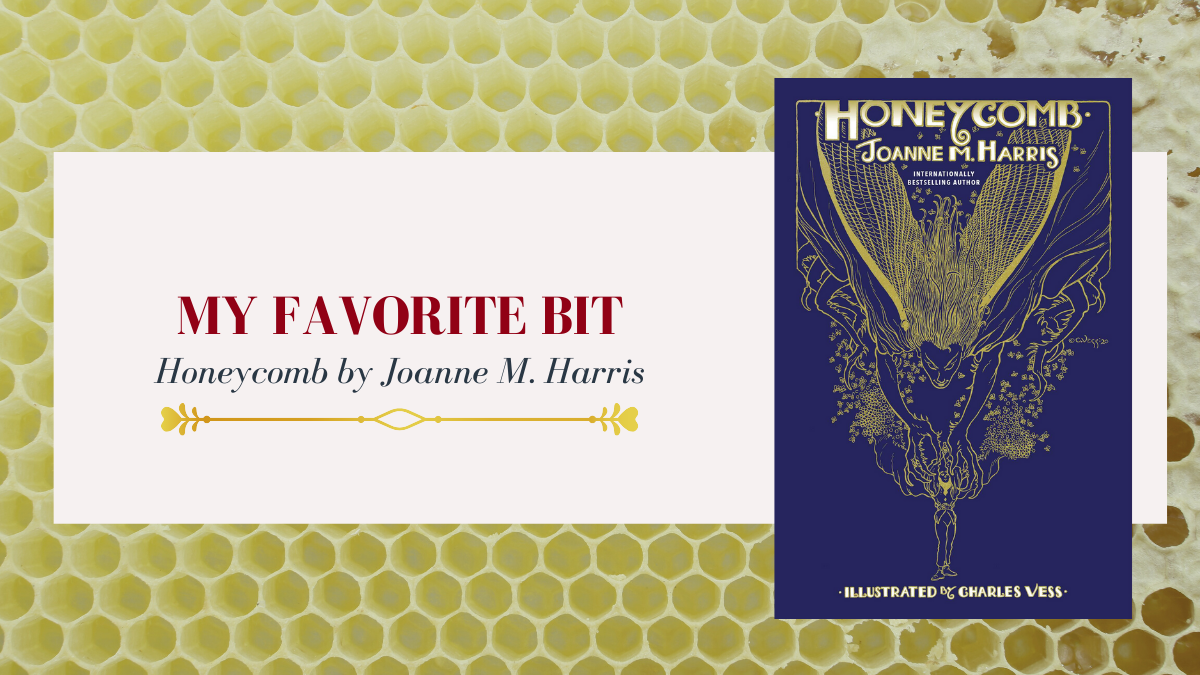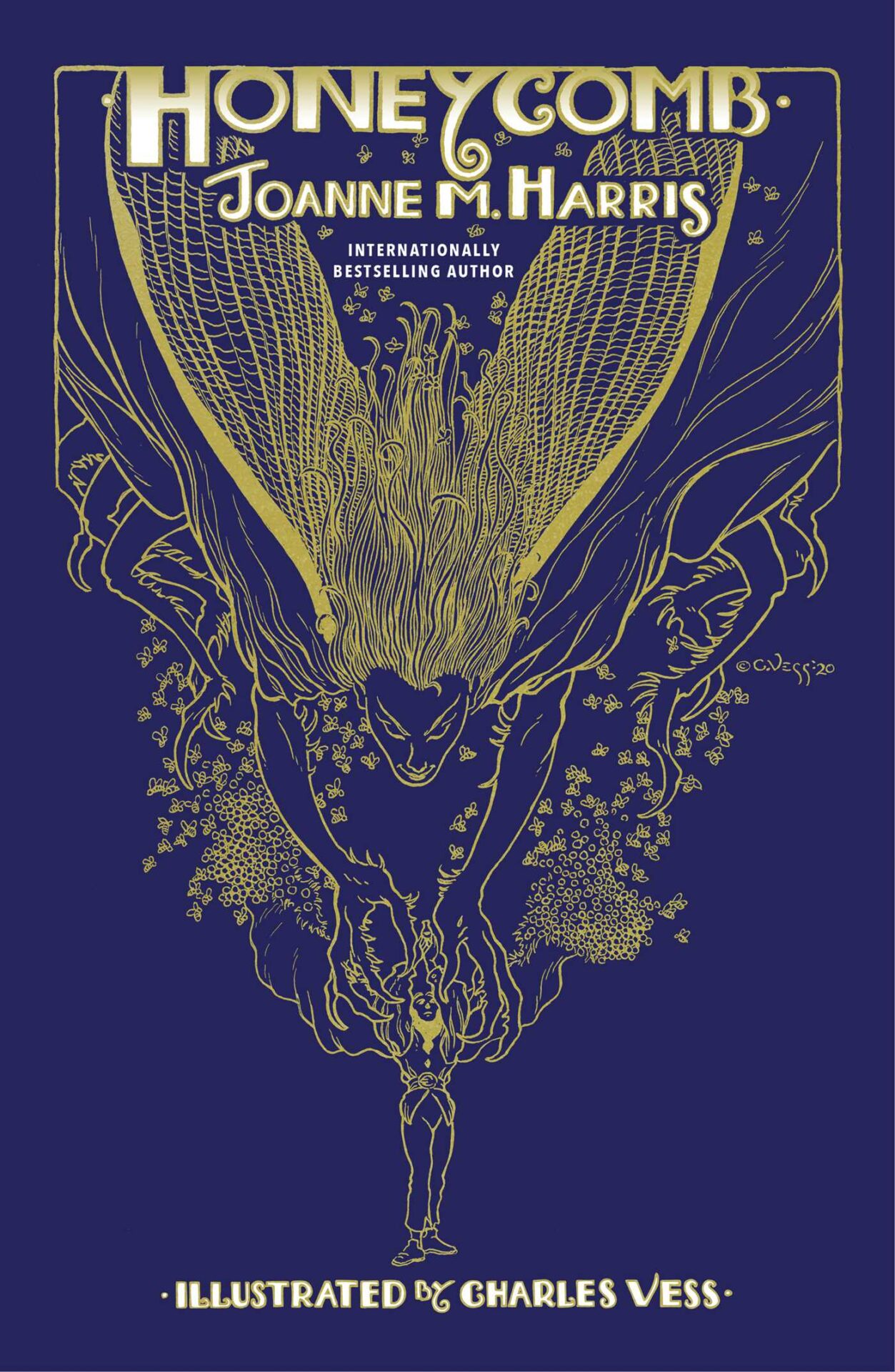
Joanne M. Harris is joining us today to talk about her novel, Honeycomb. Here’s the publisher’s description:
A lushly illustrated set of dark, captivating fairy tales from the bestselling author of The Gospel of Loki with illustrator Charles Vess (Stardust).
The beauty of stories; you never know where they will take you. Full of dreams and nightmares, Honeycomb is an entrancing mosaic novel of original fairy tales from bestselling author Joanne M. Harris and legendary artist Charles Vess in a collaboration that’s been years in the making. The toymaker who wants to create the perfect wife; the princess whose heart is won by words, not actions; the tiny dog whose confidence far outweighs his size; and the sinister Lacewing King who rules over the Silken Folk. These are just a few of the weird and wonderful creatures who populate Joanne Harris’s first collection of fairy tales.
Dark, gripping, and brilliantly imaginative, these magical tales will soon have you in their thrall in a uniquely illustrative edition.
The tales are beautifully illustrated by renowned illustrator Charles Vess (Stardust, Sandman, The Books of Earthsea).
What’s Joanne’s favorite bit?

JOANNE M. HARRIS
The idea for Honeycomb began as a response to a certain European tradition of folklore and storytelling. Storytelling, rather than story writing, is a very special medium. Because the stories are not written down, the narrative is volatile, allowing for the stories to change and develop in response to an audience; giving the storyteller a chance to comment on politics, news and day-to-day events. The fairy stories and folklore collected by the brothers Grimm, or Charles Andersen, or Francis Child were all once part of this oral tradition and have been rewritten countless times to fit the needs of our changing world.
With Honeycomb, I wanted to go back, not to the original tales, but to that oral tradition. To create a brand new set of folk tales in the style of the ones we know, incorporating modern themes, changing gender dynamics, urban myths and political fables into a more traditional world of fairies, mermaids, monsters. I used Twitter as my medium under the hashtag #Storytime because Twitter is far closer to the spoken word than the written, and I made my stories up on the spot, often in reaction to current events or pop culture. Thus, Brexit was re-imagined as a fable of barnyard animals; a tale of forced marriage was retold with an unexpected ending; old women were placed in the role of heroines rather than witches; captive princesses saved themselves, and selfish, handsome princes were given their come-uppance. Some of the stories stood alone; others were part of the narrative arc that runs through the whole of the book; a tale of betrayal, trickery, the power of story, and the redemptive nature of love.
But I needed a phrase to introduce my stories to my audience. Once upon a time was already taken; it belonged too much to a past tradition rather than the new folklore I was trying to build. I needed something of my own, something which, like the stories themselves, would sound both fresh and nostalgic. On an impulse, I came up with this:
There is a story the bees used to tell, which makes it hard to disbelieve.
It is my favourite line in the book. It was the first line I ever wrote as part of my Twitter #Storytime; and over the years, it has shaped a whole world. The central concept of Honeycomb came from that single opening line: the idea that the world – the Worlds, including Dream and Death – exist as a honeycomb multiverse with the bees – who are also the Faërie – in the role of messengers, passing between the many Worlds in search of the nectar of stories.
Why bees? Well, bees have their own long history of folklore. In many cultures, they have been seen as semi-magical creatures, surrounded by rituals and traditions. In Honeycomb, bees symbolize kindness, wisdom and the truth; their stories all have meanings for those who care to find them. But bees, like stories, can also sting, and some of these tales are very dark. Our world is increasingly under threat from selfishness, pollution and greed, and the bees are a symbol of what we may lose if we do not heed their warning.
While I was building Honeycomb on Twitter – and later rebuilding it as a book with illustrations by Charles Vess – I found myself thinking about the volatile nature of story and the way in which it likes to pass from one medium to another. Storytelling and music have long existed side by side, which was why I had the idea of taking Honeycomb to a live audience with the help of the band I’ve played in since I was sixteen. We added original music and songs to some of the stories as part of our show, #Storytime, which we took to music and literary festivals across the U.K. We gained a little following and recorded two CDs. Even I still sometimes find it hard to believe how far my Twitter stories have flown. It’s almost as if there really were a kind of everyday magic at work. Last year, just before the first lockdown, was the last time we played live. At the end of the night, a girl approached the stage as we were packing up and shyly offered to show us her #Storytime tattoo. She rolled up her sleeve, and on her arm I read the line that started it all, the line that has already travelled from oral tradition, to Twitter, to page, to illustration, to music and song and now onto this stranger’s skin. My favourite bit from Honeycomb:
There is a story the bees used to tell, which makes it hard to disbelieve.
You can read more about Storytime on my website at joanne-harris.co.uk, or listen to our work on Bandcamp.
LINKS:
BIO:
ABOUT THE AUTHOR
Joanne M. Harris is a graduate of Cambridge University and the author of three novels, including Chocolat (1999), which was made into an Oscar-nominated film starring Juliette Binoche, Johnny Depp, and Judi Dench. She is also the author of sixteen novels, two novellas, two short story collections, and many more. Her work is diverse but covers many aspects of magical realism, suspense, historical fiction, mythology, and fantasy. She is an honorary Fellow of St. Catharine’s College, Cambridge, and in 2013 was awarded an MBE by the Queen. She works from a shed in her garden, plays bass in the band she first joined when she was 16, is currently co-writing a stage musical, and lives with her husband in a little wood in Yorkshire.
ABOUT THE ILLUSTRATOR
Charles Vess is an artist and comic book illustrator, who has illustrated works by Neil Gaiman, Susanna Clarke, George R.R. Martin, and many others. Vess is primarily known for his work in fantasy, with many of his designs and drawings being implemented within major mythological based comic books and pieces.
